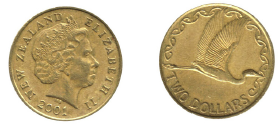This problem solving activity has a statistics focus.
When you toss 2 coins at once, will they usually land with the same side up or different sides up?
- Predict the likelihood of an event based on data collected.
- Use a systematic approach to find all possible outcomes.
- Effectively plan a mathematical exploration.
In this problem the students play a simple game that helps them begin to form an intuitive sense of what chance and possibilities mean. Theoretically, when 2 coins are tossed the chances for each outcome are ½, although with a small number or trials you probably won't get that exactly. Something that the students may not notice when they first play the game is that a same-side toss can be made in 2 ways (heads-heads or tails-tails) as can a different-side.
- 4 coins for each pair
- Copymaster of the problem (English)
- Copymaster of the problem (Māori)
The Problem
When you toss 2 coins at once, will they usually land with the same side up or different sides up?
Teaching Sequence
- Introduce the problem as a game to be played with pairs.
Players take turns, one tossing the coins while the other guesses whether the coins will land with the same side up or different sides up. Players record the results of each guess as same or different. - As the game is being played get the students to observe what is happening to the totals. Ask the students to toss the coins 20 times and write a statement on their results. You may need to model how to record the results from the coin toss (e.g. in a frequency table). They should do this again after 50 tosses.
What can you say about the totals?
Does one way of landing seem to come up more often than the other?
Is it better to guess same or different? - Share findings from the game.
Why are there different totals? (develops the notion of chance) - Pose the question: What are the different ways the coins could land?
- Let the pairs find all the possible outcomes of tossing the 2 coins. Ask that they record their work in a way that would convince others that they had found all the possible outcomes.
- Share strategies for recording outcomes.
Extension
Repeat the game with 3 coins.
Solution
When the game is played there will be variation in the results that helps develop intuitive understandings of chance. As more trials are made the results will begin to approach ½ , although it may take at 50 for this to happen.
There are 4 different outcomes when 2 coins are tossed:
- HH TT TH HT
This means that it is equally likely that they land with the same sides up as they will land with different sides up.
Solution to the Extension
(8 outcomes)
HHH HHT HTT HTH TTT TTH THH THT
Here it is less likely that all the sides will be the same.
